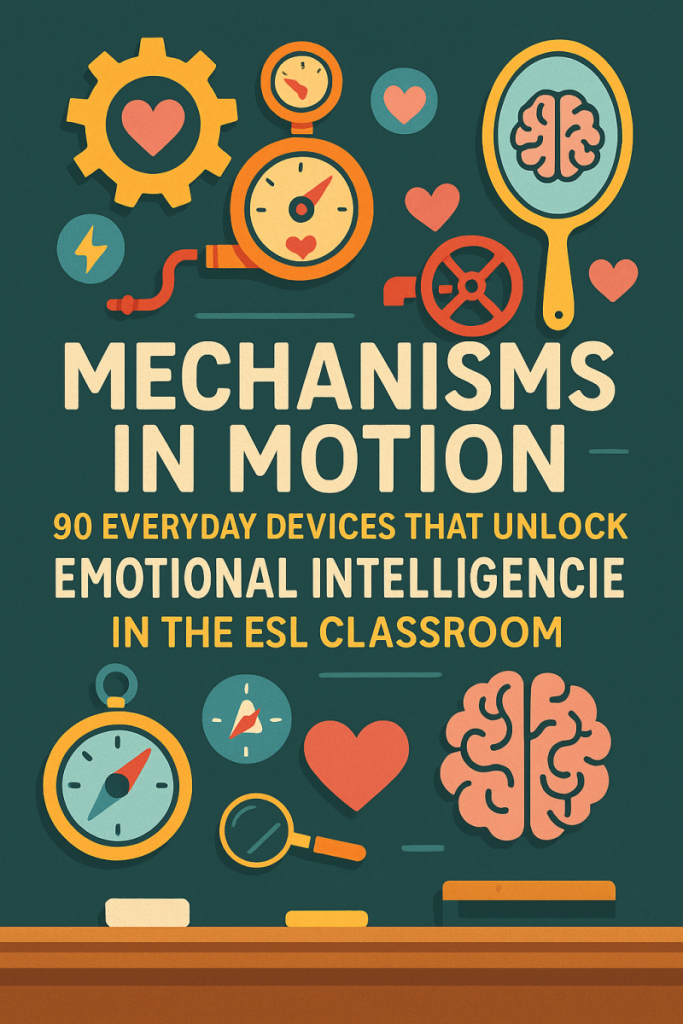“Mechanisms in Motion” invites educators to re-imagine the everyday objects that fill our homes, streets, and smartphones as living metaphors for how the human mind handles stress, conflict, and growth. By pairing 90 tangible devices—from sunglasses that hide the eyes to circuit breakers that prevent overload—with their psychological counterparts, this article shows ESL teachers how to transform wrenches, mirrors, and pressure valves into vivid language lessons. Each mechanism becomes a low-cost teaching aid that sparks curiosity, expands emotional vocabulary, and helps learners see that self-regulation is as practical—and teachable—as any piece of classroom hardware.
Plug-and-Play Lesson-Plan Template
Use this 7 step template with any of the 90 mechanism–psychology pairs.
Replace the items in bold with your chosen mechanism (e.g., pressure-relief valve, compartmentalization).
| Step | Teacher Action | Student Task | Time |
|---|---|---|---|
| 1. Visual Hook | Display a clear picture (projector, printed photo, or real object) of the physical mechanism. Briefly ask: “What is this? What does it do?” | Guess the object’s name/function using prior knowledge. | 3 min |
| 2. Vocabulary Focus | Pre-teach 5–7 keywords: the object name plus verbs/adjectives that link it to feelings (e.g., vent, release, pressure, calm). | Repeat & match words to mini-pictures or gestures. | 5 min |
| 3. Link to Psychology | Reveal the psychological mechanism (“We sometimes do the same thing in our minds…”) and give a simple definition + 1 example sentence. | Paraphrase definition in pairs; decide if the example is healthy or unhealthy. | 5 min |
| 4. Guided Reading / Mini-Story | Provide a 4 sentence scenario that uses the new vocab and shows the mechanism in action (e.g., “Maria felt angry, so she hit a punching bag to release tension.”). | Read aloud; answer 2 comprehension questions orally or on slips. | 7 min |
| 5. Communicative Practice | Role-Play or Information-Gap: One partner describes a real/imagined situation; the other suggests using mechanism as a coping strategy. | Use target phrases: “You could?__”; “That would help because?__.” | 10 min |
| 6. Personal Writing | Prompt: “Write 3–5 sentences about a time you (or someone you know) needed a pressure-relief valve for feelings.” | Draft short paragraph; optional share with partner or teacher. | 8 min |
| 7. Reflection & Exit Ticket | Quick poll: “When might this mechanism be most useful?” Collect one new word or insight on sticky notes. | Submit note; say a closing phrase using vocab: “I will vent by jogging next time.” | 2 min |
Tips for Using the Template
- One Mechanism per Lesson – keeps cognitive load manageable.
- Rotate Skill Emphasis – some days focus more on speaking, other days on writing.
- Real Objects Win – if you can bring the item (e.g., fuse, mirror, Velcro) the kinesthetic impact doubles retention.
- Cultural Sensitivity – choose mechanisms learners recognize (e.g., a tripwire alarm may resonate more in some regions than others).
- Spiral Review – revisit older mechanisms in warm-ups (“Which device prevents overload? Which one hides emotions?”).
90 tangible devices or processes that physically mirror classic psychological mechanisms
| # | Physical Mechanism / Invention | Parallel Psychological Mechanism | How the Manifestation Works |
|---|---|---|---|
| 1 | Sunglasses | Avoidance | Block eye contact and literal light-just as a person blocks awareness of uncomfortable feelings. |
| 2 | Pressure-Relief Valve | Catharsis / Venting | Releases built-up steam before the boiler explodes, like safely letting emotions out. |
| 3 | Thermostat | Homeostasis / Emotion Regulation | Constantly adjusts temperature to keep balance—mirrors how we self-regulate mood. |
| 4 | Firewall | Psychic Boundary-Setting | Filters harmful data; protects the “system” from threatening thoughts or influences. |
| 5 | Mirror | Self-Reflection / Insight | Offers a clear image back to the viewer, just as reflection brings unconscious content to awareness. |
| 6 | Noise-Canceling Headphones | Selective Attention / Suppression | Mutes outside stimuli, echoing how we tune out distressing information. |
| 7 | Shock Absorber | Resilience (Bouncing Back) | Softens the impact of bumps, akin to cushioning emotional shocks. |
| 8 | Fuse | Self-Handicapping / Safety Fail-Safe | Breaks the circuit before catastrophic overload, like pre-built excuses that prevent ego “burn-out.” |
| 9 | Chameleon Paint | Reaction Formation / Masking | Changes color to match surroundings—expresses the opposite of what’s underneath. |
| 10 | Punching Bag | Displacement | Redirects force safely away from the real target, as anger is shifted to a safer outlet. |
| 11 | Shopping Cart | Material Displacement / Consumption Coping | Symbolizes buying to fill an inner void. |
| 12 | Recycling Plant | Sublimation | Transforms waste into useful products; channels unacceptable impulses into socially valued forms. |
| 13 | Password Lock | Repression | Keeps inaccessible files behind a code, hiding memories from conscious access. |
| 14 | Smoke Alarm | Anxiety Signal | Warns of danger before flames spread, like physiological anxiety alerting us to threat. |
| 15 | Gyroscope | Ego Balance / Equilibrium | Maintains orientation despite motion—parallels the ego’s stabilizing role amid conflict. |
| 16 | Pendulum | Mood Oscillation | Swings between extremes, illustrating emotional or cognitive back-and-forth. |
| 17 | Sponge | Empathic Absorption | Soaks up liquid just as empathic individuals absorb others’ feelings. |
| 18 | Whiteboard | Cognitive Reappraisal | Allows quick erasing and rewriting—similar to reframing thoughts. |
| 19 | Magnifying Glass | Projection | Enlarges what’s “out there,” like seeing one’s own traits in others. |
| 20 | Decoy Duck | Deflection / Diversion | Attracts attention away from the real target, mirroring how jokes or side issues divert focus. |
| 21 | Autopilot | Automaticity / Habit | Runs pre-programmed routines without conscious input, as habits bypass deliberation. |
| 22 | Compass | Value Orientation | Provides consistent direction, echoing inner moral guidance systems. |
| 23 | Hourglass | Delay of Gratification | Visibly measures waiting time—like resisting impulse until “sand” runs out. |
| 24 | Safety Net | Social Support | Catches acrobats if they fall—mirrors friends catching us during crisis. |
| 25 | Conveyor Belt | Behavioral Conditioning Loop | Moves items along a fixed path, representing stimulus-response chains. |
| 26 | Telescope | Future Projection / Planning | Extends vision beyond the present, like imagining future possibilities to reduce uncertainty. |
| 27 | Filter (Water or Air) | Cognitive Filtering / Confirmation Bias | Lets some particles through, blocks others—just as minds admit congruent data and discard threats. |
| 28 | Kaleidoscope | Cognitive Restructuring | Reconfigures the same pieces into new patterns—mirrors shifting mental perspectives. |
| 29 | Camouflage Netting | Concealment / Minimization | Blurs outlines to look smaller or safer, like downplaying a problem’s seriousness. |
| 30 | Gyms’ Treadmill “Quick-Stop” Clip | Reality Check / Grounding | Halts motion immediately when clipped off—analogous to grounding techniques that snap us back to the present. |
| # | Physical Mechanism / Invention | Parallel Psychological Mechanism | How the Manifestation Works |
|---|---|---|---|
| 31 | Gutter Downspout | Channeling | Directs rainwater safely away from foundations—like steering strong feelings into acceptable outlets (e.g., sport, art). |
| 32 | Ship Ballast | Grounding / Centering | Heavy weight stabilizes a vessel in rough seas—mirrors grounding techniques that steady emotions. |
| 33 | Safety-Valve Whistle | Anxiety Early-Warning | Emits a shrill alert before pressure reaches danger—parallels somatic cues (tight chest, rapid pulse) signaling stress. |
| 34 | Periscope | Detached Observation | Lets the user see above water while remaining hidden—akin to stepping back mentally to watch thoughts without engaging. |
| 35 | Rear-View Mirror | Rumination / Past Focus | Constantly checks what’s behind; overuse can distract from the road ahead, just as dwelling on past events hampers present focus. |
| 36 | Turn Signal | Assertive Communication | Clearly indicates intended direction—model for expressing needs before acting, reducing interpersonal “collisions.” |
| 37 | Scapegoat Effigy | Scapegoating | An object symbolically blamed or sacrificed to relieve group anxiety—mirrors projecting fault onto a person or group. |
| 38 | Water-Control Dam | Repression | Holds back a vast emotional “reservoir”; cracks under strain can lead to floods of repressed material. |
| 39 | Pressure Cooker | Bottled Emotion | Seals heat inside; if not vented properly, explosive release mirrors pent-up anger outbursts. |
| 40 | Dimmer Switch | Emotion Modulation | Adjusts light intensity—symbolizes regulating feeling intensity (e.g., lowering excitement in formal settings). |
| 41 | Backup Generator | Resilience Reserve | Kicks in when primary power fails—like hidden coping resources activated during crisis. |
| 42 | Software Sandbox | Safe Experimentation / Fantasy | Isolated testing zone prevents real damage—parallels mental rehearsal or daydreaming before real-world action. |
| 43 | Tripwire Alarm | Hyper-Vigilance | Detects slight disturbances; PTSD survivors often have similar hair-trigger alert systems. |
| 44 | Parachute | Crisis Coping Plan | Deploys only when falling fast; contingency strategies cushion sudden emotional descent. |
| 45 | False-Front Facade | False Self / Image Management | Ornamental front hides an unfinished structure—mirrors presenting perfection while inner issues stay unseen. |
| 46 | Medical Face Mask | Social Anxiety Barrier | Covers mouth/nose, providing psychological as well as physical protection, muting expression. |
| 47 | Labyrinth Maze | Obsessive Loops | Complex pathways humankind willingly re-enters—model for repetitive intrusive thoughts. |
| 48 | Kitchen Sieve | Selective Memory | Lets some particles pass, holds others—like retaining confirming details while discarding contradictions. |
| 49 | Echo Chamber | Confirmation Bias Reinforcement | Reflects sound back to listener—mirrors social bubbles that amplify one’s own beliefs. |
| 50 | Metronome | Rhythm & Pacing Regulation | Provides steady beat; therapeutic breathing or pacing exercises mimic its regulatory function. |
| 51 | Gym Wall Mirror | Self-Monitoring | Allows real-time form correction—symbolizes observing one’s behavior to align with goals. |
| 52 | Buffer Tank | Emotional Buffering | Stores surplus energy so the main system isn’t overloaded—akin to spacing stressful events or using downtime. |
| 53 | Curtain / Window Blind | Privacy Boundary-Setting | Controls visibility; individuals close off parts of themselves to feel safe. |
| 54 | Clock Escapement | Incremental Release | Step-by-step ticks prevent free-fall of gears—mirrors gradual exposure therapy releasing anxiety bit by bit. |
| 55 | Bumper-Car Rubber Ring | Softened Conflict | Absorbs collision impact; humor or polite phrasing cushions interpersonal feedback. |
| 56 | Lightning Rod | Sublimation of Aggression | Channels destructive energy harmlessly to ground; sports or music redirect anger productively. |
| 57 | Stealth Cloak (Radar-Absorbent Skin) | Invisibility / Avoidance | Reduces detection signature; people minimize presence in social situations to avoid scrutiny. |
| 58 | Swiss-Army Knife | Adaptive Coping Flexibility | Multi-tool adjusts to varied problems—mirrors using diverse strategies rather than one rigid defense. |
| 59 | Jigsaw Puzzle | Meaning-Making / Integration | Assembles disparate pieces into a coherent picture—akin to therapy integrating fragmented memories. |
| 60 | GPS Re-Route Function | Cognitive Reappraisal / Flexibility | Automatically proposes a new path after a wrong turn—represents reframing setbacks as new opportunities. |
| # | Physical Mechanism / Invention | Parallel Psychological Mechanism | How the Manifestation Works |
|---|---|---|---|
| 61 | Automatic Circuit Breaker | Threshold Setting / Ego Burn-Out Prevention | Cuts power when current spikes—like shutting down activity to stop overload. |
| 62 | Shipping Container Compartments | Compartmentalization | Segregates cargo so damage in one area won’t spread—mirrors keeping life domains mentally separate. |
| 63 | Lubricant (Oil/Grease) | Social Smoothing / Facilitation | Reduces friction between moving parts—parallels diplomacy that eases interpersonal tension. |
| 64 | Velcro® Strips | Secure but Flexible Attachment | Bonds firmly yet peels away when needed—like forming ties that can detach without shattering identity. |
| 65 | Thermal / Acoustic Insulation | Emotional Shielding | Blocks heat or noise transfer—symbolizes buffering oneself from harsh criticism or drama. |
| 66 | Hologram Projection | Idealized / False Self Image | Displays a perfect 3-D likeness that isn’t tangible; people present curated versions of themselves. |
| 67 | One-Way Mirror | Detached Observation | Allows viewing others while staying unseen—akin to analyzing others’ flaws without exposing one’s own. |
| 68 | Password Manager | Controlled Disclosure | Grants access only through vetted credentials—like sharing feelings only with trusted allies. |
| 69 | Automobile Airbag | Emergency Cushioning | Deploys instantly during collision—mirrors short-term coping tactics that soften sudden emotional impact. |
| 70 | Safety-Deposit Box | Isolating Traumatic Memories | Stores valuables away from daily use; traumatic material is locked in the mind’s “vault.” |
| 71 | Traffic Light | Impulse Control / Stop-Go Regulation | Colors cue when to halt or proceed—models cognitive brakes and accelerators. |
| 72 | Cruise Control | Habitual Automaticity | Keeps pace with minimal input—daily routines run without conscious thought. |
| 73 | Camera Gimbal Stabilizer | Affect Regulation / Steady Presence | Cancels shaky motion; emotion-regulation skills steady mood swings. |
| 74 | Global Seed Vault | Resilience Reserve / Long-Term Memory | Stores genetic backups for disasters—mirrors deep memories that preserve identity under stress. |
| 75 | Detour Sign | Strategic Avoidance / Diversion | Reroutes traffic around obstacles—like sidestepping triggers until one is ready. |
| 76 | Secret Decoder Ring | Cognitive Reframing / Meaning-Making | Translates hidden codes; therapy helps decode events into new perspectives. |
| 77 | Magnet (Attract/Repel) | Transference & Projection | Pulls compatible metals, repels like poles—mirrors pulling familiar traits onto others or pushing them away. |
| 78 | Surge Protector (Electrical) | Emotion Surge Suppression | Absorbs voltage spikes, protecting devices—analogous to grounding exercises during anger spikes. |
| 79 | Heat Sink | Venting / Dissipation | Draws heat out of CPUs—talking or exercise dissipates emotional “heat.” |
| 80 | Sound Baffle | Rumination Containment | Dampens echoes in a room; journaling confines repetitive thoughts to pages. |
| 81 | Storm / Tornado Shelter | Regression to Safe Space | Temporary retreat below ground in severe weather—people retreat into childhood comforts during crisis. |
| 82 | Biometric Lock | Identity Assertion / Authenticity Check | Opens only to a unique fingerprint—asserts boundaries of the true self. |
| 83 | Audio Noise Gate | Selective Disclosure | Mutes low-level background hum; individuals filter minor worries before sharing. |
| 84 | Buffer Overflow Guard (Software) | Meltdown Prevention | Stops excess data spilling into memory—similar to breaks that halt spiraling thoughts. |
| 85 | Mood Ring (Biofeedback Jewelry) | Affective Awareness | Changes color with temperature; wearable tech gives clues to emotional state. |
| 86 | Infrared Night-Vision Goggles | Insight into the Unconscious | Reveals shapes hidden in darkness—therapy uncovers unseen motives. |
| 87 | Circuit Delay Timer | Procrastination / Temporal Distancing | Inserts a pause before activation—like delaying tasks to avoid anxiety. |
| 88 | Camera Aperture (Diaphragm) | Emotional Openness Control | Widens or narrows light entry—people choose how much vulnerability to “expose.” |
| 89 | Wind-Turbine Yaw System | Reorientation / Adaptability | Rotates blades to face changing winds—resilient minds pivot toward new goals. |
| 90 | Flight Recorder “Black Box” | Post-Trauma Processing & Learning | Captures data during disaster for later analysis—reflective journaling after crises extracts lessons. |
Taken together, these ninety pairings and the plug-and-play lesson template form a toolkit for weaving emotional intelligence seamlessly into everyday language practice. Whether you spotlight one gadget a week or build a full elective around the theme, students will leave class with richer English, sharper self-awareness, and a deeper appreciation for the inventiveness of both engineers and the human psyche. Keep the mechanisms in motion—pick up a real object, connect it to an inner process, and watch your learners unlock new words and new insights at the same time.



